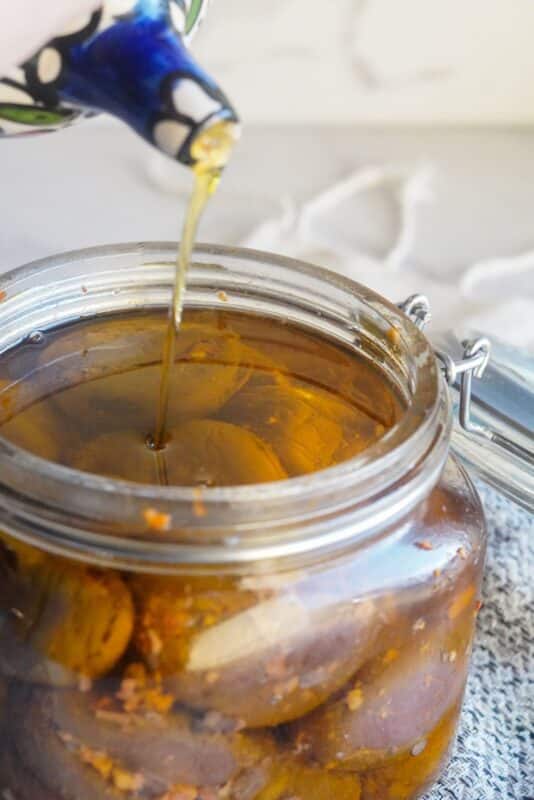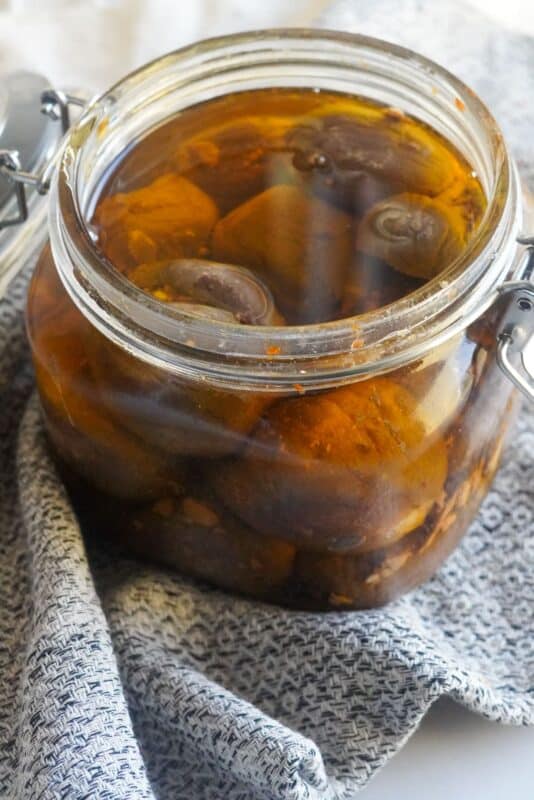Tiny, smooth, and tangy stuffed eggplants, Makdous is an integral part of the Mediterranean breakfast table. Almost every single Middle Eastern family makes these oil-cured eggplants at home.
This homemade stuffed eggplant recipe requires few ingredients. Trust me, making this dish at home will make you realize how unique it is and and allow you to gain a better understanding of Levantine customs, traditions, and heritage.
Deliciousness in a Jar

What is Makdous?
Makdous is a culinary heritage that characterizes the Middle Eastern mezze, especially in Lebanon, Syria, Palestine, and Jordan.
This integral part of the Levantine breakfast table is baby eggplants blanched in salted water and stuffed with a flavorful mix of shatta, garlic cloves, and coarsely chopped walnuts.
These traditional stuffed Makdous are preserved in olive oil to be enjoyed at any time of the year and tickle your taste buds.
Middle Eastern Side Dish

Let’s Prepare a Middle Eastern Breakfast
Makdous is a delicious breakfast staple across the Middle East. We have it for breakfast, lunch, and everything in between.
I especially love eating Makdous with the Authentic Labneh Balls I make. The combination is just to die for!
If you are looking for a satisfying meal, then you have to add a warm Ful Medames plate to your table alongside a delectable spicy sauce (Shatta).
Enjoy your breakfast with warm fresh pita bread, flatbread, a baguette, or Shrak bread -known as Markook bread. You can also serve them with Bazlama, a Turkish flatbread.
You have a wide selection of fluffy golden pastries for you to impress your family, friends, and guests when you have them over for breakfast.
Zaatar Rolls, Cheese Fatayer, Crispy Cheese Borek, and Spinach Fatayer are well-known Middle Eastern pastries that will get you hooked once you try them.
If you like the harmony of zaatar and cheese, then you should absolutely try Zaatar and Cheese Breakfast Bake and Tender Zaatar Cheese Buns.
Warm your breakfast by sipping a cup of hot Middle Eastern Mint Tea. It will bring warm vibes to breakfast gatherings.
Decorate your table with small bowls of pickled black or green olives and enrich it with a wide variety of fresh veggies. Try to add fresh mint, green onions, cucumbers, radishes, and tomatoes.
Prepare your own Middle Eastern breakfast by trying some of the above suggestions and let me know how much you enjoy it in the comments section below.
Enrich Your Breakfast

Tips and Tricks for Best Makdous
Don’t overcook the eggplants as they will get mushy.
If you boil the eggplants, cut into them, and see black, then discard them. Those eggplants are beginning to rot.
Avoid adding salt to the filling since we salted the eggplants already.
When you take eggplants out of the jar, make sure that there is enough olive oil to cover them. This prevents mold.
If at any point you see black or anything moldy on the eggplants after adding the olive oil, discard the affected eggplant.
A Jar of Pickled Makdous

Frequently Asked Questions (FAQs)
Traditionally, baby eggplants are used to make Middle Eastern Makdous. They are perfect for fitting in the glass jar and being pickled in olive oil.
To make non-spicy Makdous, use sweet red bell pepper in the filling instead of spicy shatta.
Store the Makdous jar in a cool dark place. Make sure that you close the lid of the jar tightly each time you grab some stuffed eggplants to prevent mold.
Yes for sure! Vegetable oil also works well to cover Makdous.
Pin It

You’ll Need:
To make Makdous, you will need the following simple ingredients:
Baby eggplants
Salt
Walnuts
Sugar
Cloves garlic
Shatta
Olive oil
A Wonderful Filling

How to Make Makdous?
How to Prepare the Eggplants?
Cut off the stem from each eggplant, or you can do so after boiling them.
To a large pot, add water to more than triple the amount of eggplants and place on high heat to boil.
Once the water is boiling, add the baby eggplants and boil for 8-10 minutes then strain and let them sit to drain and cool.
Once cooled, make a deep slit in the middle of each eggplant and place ¼ teaspoon of salt in each eggplant.
Close back up and place in a large strainer once again, lined up flat.
Once lined up, sprinkle ½ tablespoon of salt on top of all the eggplants and place a large item that is heavy on top of the eggplants to extract all the liquids out. Leave it like this for 2 days.
You want to make sure there is no water left in the eggplants, as this will make them moldy.
So every few hours, rotate the eggplants in the strainer to make sure each one is getting squeezed properly.
Once two days are up, pat dry the eggplants and you can work on the filling.
How to Make the Filling?
Mix together the walnuts, shatta, sugar, and garlic. Adjust the taste to your liking.
How to Stuff the Eggplants?
Once you make the filling, then stuff each eggplant generously. Place into a clean, airtight glass jar.
Now as a precaution, invert the glass jar (while the eggplants are in it) into a strainer just to make sure there is absolutely no water left. Again, we’re avoiding mold.
After a full 24 hours, place the jar right side up making sure the eggplants are tightly packed next to each other.
Add olive oil to cover, and close tightly with an airtight lid. Let it sit at room temperature for 12-14 days.
After 12-14 days, if you follow all the steps properly, the eggplant should be softer and easier to pull apart with bread, and it’s not discolored.
Shiny Appetizer for You

Must-Try Recipes:
Middle Eastern Kufta Bil Tahiniye
Sheikh Makhshi (Kusa Bi Laban)
Kousa Mahshi (Stuffed Grey Squash)
If you’ve tried this recipe, don’t forget to rate it and leave a comment below! I would love to hear about your experience. You can follow me on Facebook, Instagram, and YouTube.

Makdous
Ingredients
For the Eggplants:
- 20 baby eggplants about 1½ pounds to 1¾ pounds
- ¼ teaspoon salt per eggplant
- ½ tablespoon salt for straining
- olive oil to cover
For the Filling:
- 1 cup walnuts coarsely chopped
- ½ tablespoon sugar
- 10 cloves garlic
- ¼ cup shatta
Instructions
How to Prepare the Eggplants?
- Cut off the stem from each eggplant, or you can do so after boiling them.
- To a large pot, add water to more than triple the amount of eggplants and place on high heat to boil.
- Once the water is boiling, add the baby eggplants and boil for 8-10 minutes then strain and let them sit to drain and cool.
- Once cooled, make a deep slit in the middle of each eggplant and place ¼ teaspoon of salt in each eggplant.
- Close back up and place in a large strainer once again, lined up flat.
- Once lined up, sprinkle ½ tablespoon of salt on top of all the eggplants and place a large item that is heavy on top of the eggplants to extract all the liquids out. Leave it like this for 2 days.
- You want to make sure there is no water left in the eggplants, as this will make them moldy.
- So every few hours, rotate the eggplants in the strainer to make sure each one is getting squeezed properly.
- Once two days are up, pat dry the eggplants and you can work on the filling.
How to Make the Filling?
- Mix together the walnuts, shatta, sugar, and garlic. Adjust the taste to your liking.
How to Stuff the Eggplants?
- Once the filling is made, stuff each eggplant generously. Place into a clean, airtight glass jar.
- Now as a precaution, invert the glass jar (while the eggplants are in it) into a strainer just to make sure there is absolutely no water left. Again, we’re avoiding mold.
- After a full 24 hours, place the jar right side up making sure the eggplants are tightly packed next to each other.
- Add olive oil to cover, and close tightly with an airtight lid. Let it sit at a room temperature for 12-14 days.
- After 12-14 days, if all the steps are followed properly, the eggplant should be softer and easier to pull apart with bread, and it’s not discolored.
Notes
- Don’t overcook the eggplants as they will get mushy.
- If once you boil the eggplants, cut into them, and see black, then discard them. Those eggplants are beginning to rot.
- Avoid adding salt to the filling since we salted the eggplants already.
- Whenever you take eggplants out of the jar, make sure there is enough olive oil to cover them. This prevents mold.
- If at any point you see black or anything moldy on the eggplants after adding the olive oil, discard the affected eggplant.











